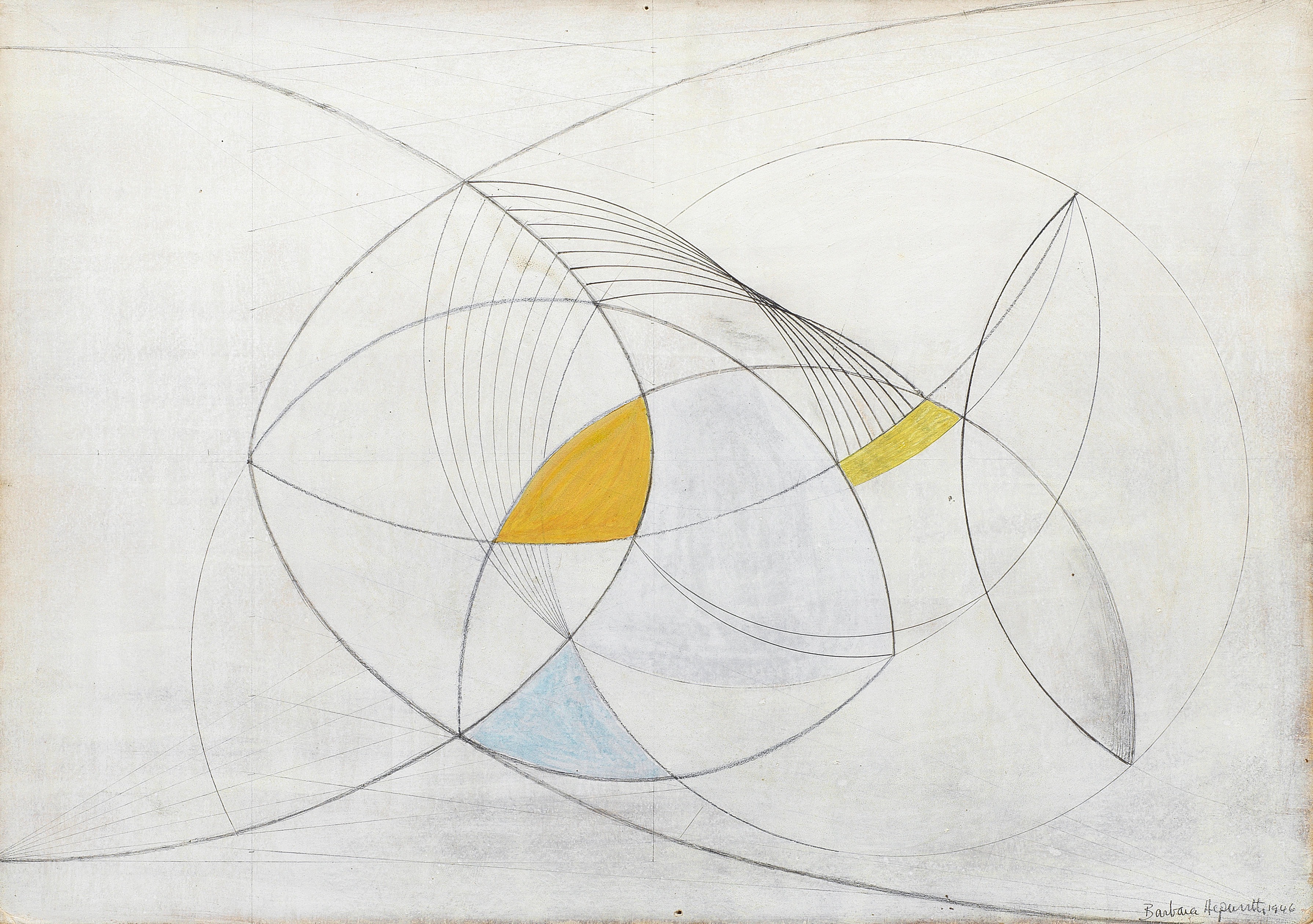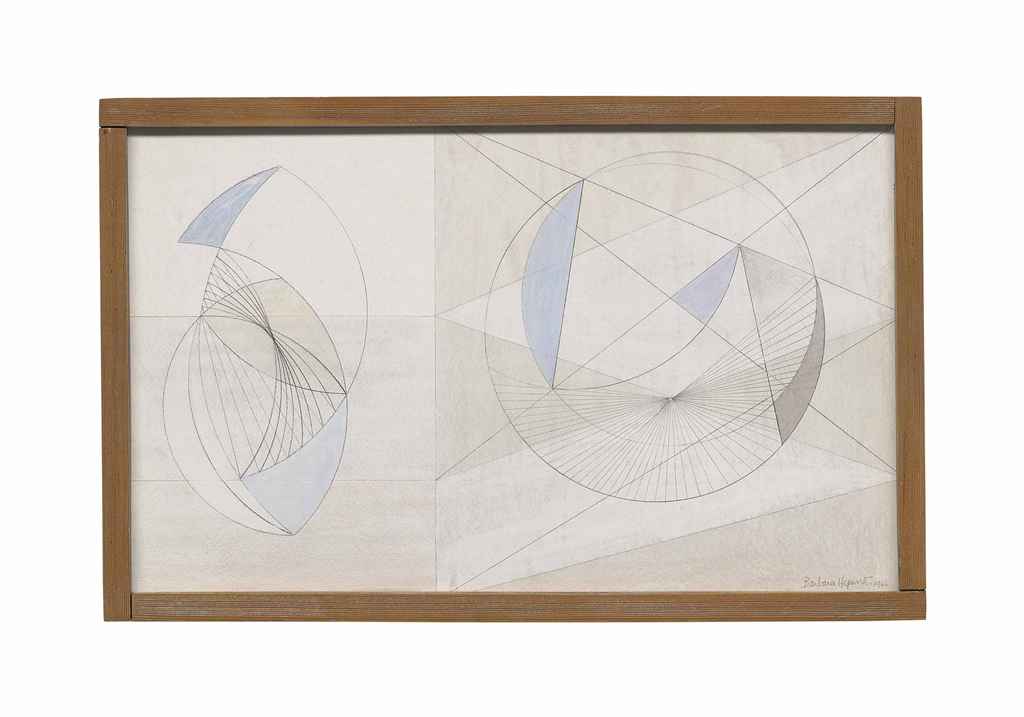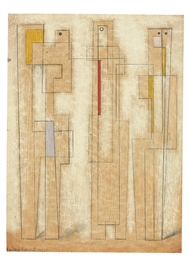12 Dame Barbara Hepworth Stringed Figure (Curlew) (Version I) 1956 brass and string with original wooden base 46.4 x 55.9 x 34.5 cm (18 1/4 x 22 x 13 5/8 in.) This work is number 5 from an edition of 9.
Provenance Grosvenor Gallery, London Private Collection, Cambridge, Massachusetts (1969) Marlborough Fine Art, London The Hokin Gallery, Palm Beach Christie's, New York, Impressionist & Modern Paintings, Drawings & Sculpture, Part II, 11 May 1995, lot 407 Achim Moeller Fine Art, New York Christie's, New York, Impressionist and Modern Art Evening Sale, 7 November 2012, lot 58 Acquired at the above sale by the present owner Literature J.P. Hodin, Barbara Hepworth Neuchâtel, 1961, no. 225, p. 169 (another example illustrated) A.M. Hammacher, Barbara Hepworth New York, 2004, no. 100, pp. 210 and 210 (another example illustrated) Dr. Sophie Bowness will include this sculpture in her forthcoming revised catalogue raisonné of the artist's work as BH 225 A. Catalogue Essay Barbara Hepworth created Stringed Figure (Curlew) (Version I), the larger precursor to Stringed Figure (Curlew) (Marquette), in her studio in St. Ives in 1956. This magnificent sculpture marks a short but meaningful period in the artist’s oeuvre. In the 1950s, Hepworth began to explore the sculptural medium of sheet metal. This medium brought greater freedom than bronze or wood; it allowed for more exaggerated and parabolic curves to be created with ease. The use of new materials is partly explained due to the demand for her work. Working in a more malleable and new material not only allowed the artist to create the work in time to meet the demand but also allowed her to expand her expertise in a new direction. Moreover, there are three works in total that have this same title, as well as this same technique which was used to develop other commissions such as the Orpheus (Maquette 2) (Version II) , further demonstrating not only her continuous artistic evolution but also her commercial success. Aside from the brass, Hepworth also used cotton fisherman’s string, which she acquired locally. Hepworth always had a deep appreciation for St. Ives and it seems natural that the love she felt for the town was extended into her artworks. The overall rounded and curved appearance of the sculpture owes its shape to Hepworth’s fascination with flight. In an interview she explained that she had always been interested in 'forms of the human head or of a bird. Gradually my interest grew in more abstract values –the weight, poise, and curvature of the ovoid as a basic form. The carving and piercing of such a form seems to open up an infinite variety of continuous curves in the third dimension, changing in accordance with the contours of the original ovoid and with the degree of penetration of the material. Here is sufficient field for exploration to last a lifetime.' (Extract from 'Approach to Sculpture', The Studio, London, vol. 132, no. 643, October 1946) Indeed, flight and birds were a life-long preoccupation for Hepworth. This was accentuated by the sudden and tragic death of her son Paul, who died in a plane crash while he was serving with the Royal Armed Force in Thailand just two years prior to the production of this work. In the late 1960s, Hepworth stated that 'man's discovery of flight has radically altered the shape of our sculpture, just as it has altered our thinking' (Mullins, 1970). This delicate, airy, and light sculpture, despite its different medium, finds parallels with other works within Hepworth’s oeuvre of magnanimous importance, for instance, Winged Figure of 1963, retains some of the same exaggerated curves and string elements. Moreover, parallels can be drawn with the work of other artists from the time such as Lynn Chadwick’s Stabile with Mobile Element 1951). At the time Chadwick was also exploring the varying possibilities of balance, contour, and form that could be developed using sheet metal. Stringed Figure (Curlew) (Version I) conveys a rhythmic quality of movement - similar to that of a bird mid-flight - and explores shape and space in a formal yet innovative way. Read More
12 Dame Barbara Hepworth Stringed Figure (Curlew) (Version I) 1956 brass and string with original wooden base 46.4 x 55.9 x 34.5 cm (18 1/4 x 22 x 13 5/8 in.) This work is number 5 from an edition of 9.
Provenance Grosvenor Gallery, London Private Collection, Cambridge, Massachusetts (1969) Marlborough Fine Art, London The Hokin Gallery, Palm Beach Christie's, New York, Impressionist & Modern Paintings, Drawings & Sculpture, Part II, 11 May 1995, lot 407 Achim Moeller Fine Art, New York Christie's, New York, Impressionist and Modern Art Evening Sale, 7 November 2012, lot 58 Acquired at the above sale by the present owner Literature J.P. Hodin, Barbara Hepworth Neuchâtel, 1961, no. 225, p. 169 (another example illustrated) A.M. Hammacher, Barbara Hepworth New York, 2004, no. 100, pp. 210 and 210 (another example illustrated) Dr. Sophie Bowness will include this sculpture in her forthcoming revised catalogue raisonné of the artist's work as BH 225 A. Catalogue Essay Barbara Hepworth created Stringed Figure (Curlew) (Version I), the larger precursor to Stringed Figure (Curlew) (Marquette), in her studio in St. Ives in 1956. This magnificent sculpture marks a short but meaningful period in the artist’s oeuvre. In the 1950s, Hepworth began to explore the sculptural medium of sheet metal. This medium brought greater freedom than bronze or wood; it allowed for more exaggerated and parabolic curves to be created with ease. The use of new materials is partly explained due to the demand for her work. Working in a more malleable and new material not only allowed the artist to create the work in time to meet the demand but also allowed her to expand her expertise in a new direction. Moreover, there are three works in total that have this same title, as well as this same technique which was used to develop other commissions such as the Orpheus (Maquette 2) (Version II) , further demonstrating not only her continuous artistic evolution but also her commercial success. Aside from the brass, Hepworth also used cotton fisherman’s string, which she acquired locally. Hepworth always had a deep appreciation for St. Ives and it seems natural that the love she felt for the town was extended into her artworks. The overall rounded and curved appearance of the sculpture owes its shape to Hepworth’s fascination with flight. In an interview she explained that she had always been interested in 'forms of the human head or of a bird. Gradually my interest grew in more abstract values –the weight, poise, and curvature of the ovoid as a basic form. The carving and piercing of such a form seems to open up an infinite variety of continuous curves in the third dimension, changing in accordance with the contours of the original ovoid and with the degree of penetration of the material. Here is sufficient field for exploration to last a lifetime.' (Extract from 'Approach to Sculpture', The Studio, London, vol. 132, no. 643, October 1946) Indeed, flight and birds were a life-long preoccupation for Hepworth. This was accentuated by the sudden and tragic death of her son Paul, who died in a plane crash while he was serving with the Royal Armed Force in Thailand just two years prior to the production of this work. In the late 1960s, Hepworth stated that 'man's discovery of flight has radically altered the shape of our sculpture, just as it has altered our thinking' (Mullins, 1970). This delicate, airy, and light sculpture, despite its different medium, finds parallels with other works within Hepworth’s oeuvre of magnanimous importance, for instance, Winged Figure of 1963, retains some of the same exaggerated curves and string elements. Moreover, parallels can be drawn with the work of other artists from the time such as Lynn Chadwick’s Stabile with Mobile Element 1951). At the time Chadwick was also exploring the varying possibilities of balance, contour, and form that could be developed using sheet metal. Stringed Figure (Curlew) (Version I) conveys a rhythmic quality of movement - similar to that of a bird mid-flight - and explores shape and space in a formal yet innovative way. Read More
.jpg)
.jpg)
.jpg)



.jpg)


.jpg)
.jpg)
.jpg)


.jpg)
Try LotSearch and its premium features for 7 days - without any costs!
Be notified automatically about new items in upcoming auctions.
Create an alert